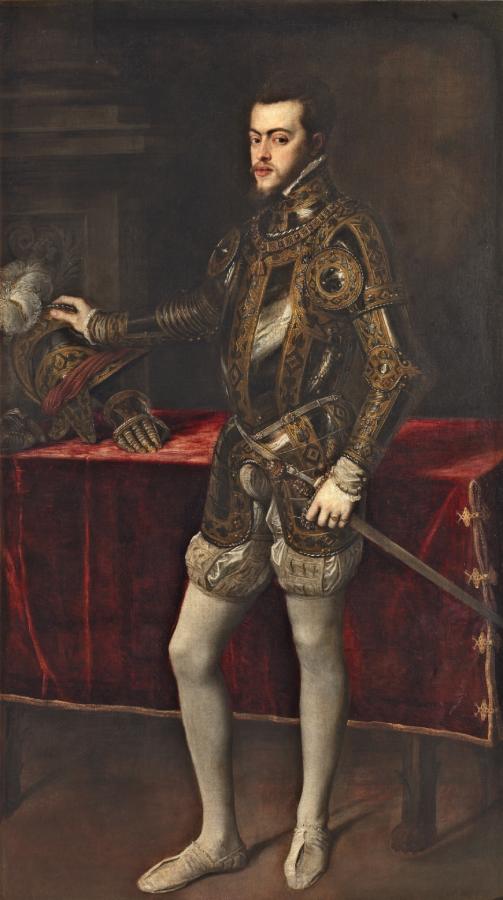Tiziano (c.1488-1576)
Ritratto di Filippo II in armatura (Portrait of Philip II in Armour)
1551
Oil on canvas, 193 cm x 111 cm
Museo del Prado, Madrid
Philip II was Titian’s most important patron, and the pair’s artistic relationship was one of the most fecund of the Renaissance. They met twice while Philip was still a prince, in Milan (December 1548-January 1549) and Augsburg (November 1550–1551), and Titian painted the prince’s portrait on both occasions. On 29 January 1549 Philip paid the painter 1000 escudos for certain portraits he paints at my behest, including his own, which he received on 9 July, after Titian had made replicas for Philip’s aunt, Queen Mary of Hungary, and Antoine Perrenot de Granvela. Titian again painted the prince in Augsburg. On May 16, 1551, Philip wrote to Queen Mary of Hungary: This [letter] accompanies Titian’s portraits… mine in armour is a good likeness, though made with haste, and if there were more time I would have him do it again.
The Museo del Prado’s painting is considered to be the one mentioned by Philip in 1551, as it is the only surviving or documented portrait of him in armour. Charles Hope disagrees, believing that the work’s finished appearance does not justify Philip’s criticism. Hope instead dates it from Philip and Titian’s first meeting in Milan. Beyond the difficulty of interpreting Philip’s use of the word haste (traditionally it is associated with an unpolished painting, but could also allude to one of poorer quality), Hope is correct in considering this a magnificent and considerably detailed portrait. However, that does not invalidate dating it from 1551.
As with the portrait from 1548–49, various replicas were made of the one from 1550–51. The inventories of both Philip (1553) and Queen Mary of Hungary (1558) reveal the existence of identical portraits whose descriptions match that of the Museo del Prado’s work. The fact that the painting sent to Mary in 1551 was a replica would explain both its hasty execution and its lesser quality (Hurtado de Mendoza had already informed Philip in 1549 that the replicas of his first portrait lacked the quality of the original). This would mean the Museo del Prado’s painting is the original from 1550–51, which Philip kept for himself, while Mary’s replica has disappeared. The first portrait is known from a workshop replica. X-rays have revealed that Titian painted it over a portrait of Philip’s father, Charles V, who appears in armour and is identical to the painting that disappeared in the fire at El Pardo in 1604, which is known through copies by Juan Pantoja de la Cruz.
The present likeness is not so much an exercise in psychological introspection as an exaltation of the prince’s dignity. Titian portrays him with a ‘gesto bel di maestá reale’ (grand gesture of regal majesty), as Pietro Aretino said of the 1549 portrait. This explains the work’s emphasis on representative elements such as the column, the table covered with crimson velvet and the imposing armour crafted by Colman Helmschmid of Augsburg. Titian employed his respected ability to smoothly idealise his models, rendering a more svelte Philip that does not recall the sturdy individual of medium stature that he actually was. Along with a contemporaneous portrait that Antonio Moro painted for the Habsburgs, the present work established a model for courtly representations that lasted for more than a century. It is one of Titian’s most influential works (Text drawn from Falomir, M.: Italian Masterpieces. From Spains Royal Court, Museo del Prado, 2014, p. 78).
See also:
• Felipe II (1527-1598)
